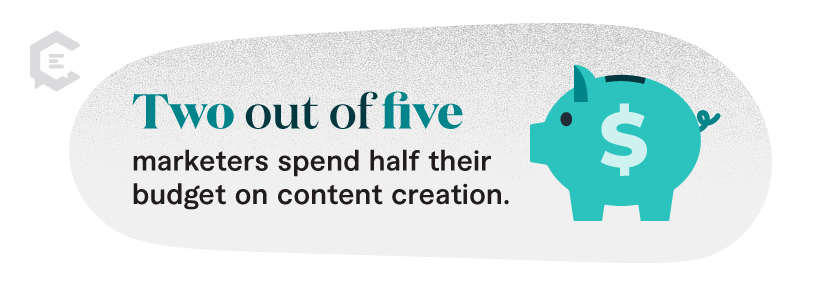Great content marketing strategies aren’t great by accident. They’re the product of very specific behaviors and techniques. That’s especially true when managing and outsourcing your content.
At ClearVoice, we’ve worked with thousands of clients in dozens of industries. Although each client is unique, many of the most successful ones share key practices within their processes.
So, what do those customers do? Well… let’s talk about it.
How Outsourcing Can Maximize Your Marketing Impact
With budgets tightening and the marketing landscape shifting, it’s time to re-examine the traditional marketing model of relying solely on an in-house team. The gig economy is booming. Over 150 million people work as independent contractors in North America and Western Europe. By 2027, over half of the U.S. workforce is predicted to participate in the gig economy.
A lot of companies are already incorporating these specialized workers:
- 57 percent of the most successful marketers outsource content activities
- 84 percent hire contractors specifically for content creation
[CMI]
The most obvious benefit to outsourcing is its cost-effectiveness. Two out of five marketers spend half their budget on content creation. A lot of that can get eaten up by keeping a full-time content creation team on staff. Outsourcing eliminates those overhead costs. You just have to know how to navigate it the right way.
The benefits don’t end there. You also get:
- Access to Specialized Skillsets and Expertise: One of the biggest values of outsourcing is its cross-section of cost-effectiveness with high-level talent. It connects you to a global talent pool that offers specialized skills that might not be available in-house. It also allows for content creation expertly tailored to specific niches, enhancing your content’s quality and relevance. Plus, there’s nothing better than optimizing your team without increasing headcount.
- Scalability and Flexibility: As marketers, our content creation needs change throughout the year. With outsourcing, you can easily reduce or ramp up your content production depending on what you need. That adaptability is crucial for responding quickly to changing market trends and tech developments, which may affect your marketing goals and content creation needs. It also offsets the workload of your core content team.
How the Successful Marketers Work with Contractors
Alright, you’ve decided to outsource some of your content creation (if that’s the case for you, congrats! Download our step-by-step outsourcing guide to ensure success). Before you start, here are four key things to remember when working with freelancers/outsourced content production.
1. Culturally onboard your contractors
When outsourcing, you can’t just hand freelancers a brief and expect magic. You have to integrate them into the culture of your company. Just because they don’t work in your office doesn’t mean you don’t want a lasting relationship. Plus, freelancers are much more motivated when they feel connected to the teams they’re working with.
Immerse them in your brand story and help them grasp the essence of what your company stands for. That understanding often translates into higher-quality content that feels authentic and aligned with your brand identity.
Ensure your outsourced team is aware of your content marketing strategy’s broader vision and specific goals. They can create more targeted and strategic pieces when they understand the ‘why’ behind your content and where they fit in the grand scheme of everything.
2. Establish a singular point of contact
We work with teams ranging from a single individual to groups of up to 30 people. No matter how many people are involved in the overall process (ideating, planning, coordinating, editing, approving), not all need to give feedback. In fact, the more people involved, the more crucial it is to streamline communication. When multiple team members interact directly with freelancers, it significantly increases the risk of miscommunication and conflicting directives.
Our most successful clients typically appoint one person as the primary point of contact for their engagement. This individual’s role is to collate and consolidate feedback from all the relevant stakeholders and ensure the message is coherent and unified. Then, they communicate this streamlined, clear, and linear feedback to us and the freelancers.
This approach simplifies the communication flow and also helps avoid conflicting instructions about the next steps, edits, and contact points. Besides maintaining clarity, it’ll save you time and effort for everyone involved as the project progresses smoothly and efficiently.
3. Provide brand and editorial guidelines
One of our client’s biggest concerns when outsourcing is maintaining brand consistency. Thank god for brand guidelines. And editorial guidelines (we didn’t forget about you).
Brand guidelines are the verbal and visual elements that shape and define your brand. They keep your team on the same page when choosing colors, images, language, and fonts. Editorial guidelines keep your brand’s voice consistent across all your content creation.
Together, these two sets of guidelines help ensure that everyone involved in creating content for your brand — from employees to freelancers — is on the same page regarding style, tone, and messaging. Think Nike or Apple.
The best clients have airtight, clear guidelines that are easy for freelancers to follow. It allows them to create detailed briefs that communicate exactly what they want to writers and gives freelancer editors a template to follow when they’re redlining copy.
If you’re unsure where to start or want a refresher, here’s everything you need to know about brand and editorial guideline creation.
4. Encourage open communication
Honestly, this could easily be number one on this list. Communication is the cornerstone of any successful collaboration, and your relationship with your outsourced team is no different.
Set up a structured communication process to ensure everyone is on the same page. It can be regular check-ins, weekly syncs, or daily updates. Technology is your best friend here. Collaborative tools like Slack, Trello, and Asana can help keep your projects and conversations organized and accessible.
As you work together, create an inclusive environment where contractors feel like part of the team. Build a safe space where two-way feedback is welcomed and valued, and allow your outsourced team to provide input and suggestions. Include them in relevant meetings and team-building activities, even if it’s virtually.
Bonus tip: Build personal connections
Most, if not all, of your outsourced team will be remote. Despite that, or maybe even because of it, try to build personal connections. It’ll strengthen your collaborative working relationship.
Simple gestures like remembering birthdays, acknowledging achievements, or casual virtual coffee breaks and lunches can make outsourced team members feel valued and part of the team. And that will make them work for you that much harder, setting up long-term collaboration success.
Feeling Ready to Outsource?
Outsourcing, when done right, can maximize your content marketing impact. At ClearVoice, we understand the decision to outsource is pivotal for your company. Whether you’re looking to create a few content pieces or craft a long-term campaign, we’re here to help you with every step of the process.
With our network of over 4,000 vetted, experienced freelancers and commitment to seamless workflows, we’ll keep your outsourcing smooth, efficient, and impactful. Connect with us today to see how we can expand your brand’s potential.









